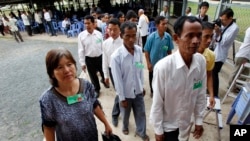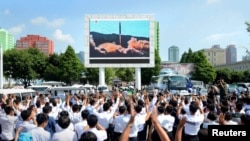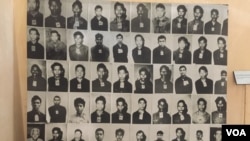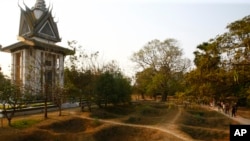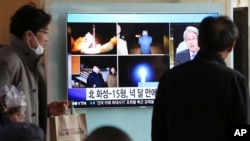Extrajudicial killings, systematic torture, arbitrary detention, forced labor, rape, starvation, restriction of freedoms, the list goes on. These human rights issues in North Korea undoubtedly “remain among the worst in the world,” as the U.S. Department of State said in a statement released late October.
Although analysts believe that human rights violations have been committed in North Korea for decades, the issue gained increasing attention from the world community since 2004 when the United Nations passed the very first resolution on North Korean human rights.
More importantly, in 2014, the UN Commission on Inquiry of Human Rights in North Korea found that “systematic, widespread and gross human rights violations have been and are being committed by the Democratic People’s Republic of Korea, its institutions and officials.” Most of the violations committed by the North Korean leadership “constitute crimes against humanity,” concluded the UN Commission. “[These] crimes against humanity are ongoing in the Democratic People’s Republic of Korea because the policies, institutions, and patterns of impunity that lie at their heart remain in place.”
Then in that same year, the UN General Assembly passed a landmark resolution calling for the North Korean leadership to be referred to the International Criminal Court over alleged crimes against humanity.
The UN’s decision sent a clear message that human rights violations in the isolated communist country cannot be ignored and that the perpetrators will one day be brought to justice.
As past experiences from other countries, especially Cambodia, revealed, those responsible for serious international crimes will eventually be brought before a court.
In November last year, the Extraordinary Chambers in the Court of Cambodia (ECCC), which was established more than a decade ago to prosecute “those most responsible” for the crimes committed during the Khmer Rouge reign in the 1970s, upheld life sentences for Nuon Chea and Khieu Samphan, two top former Khmer Rouge leaders, for crimes against humanity.
After the trial, David Scheffer, the UN Secretary General’s envoy to the Khmer Rouge tribunal, delivered a strong message to North Korea that "perhaps the leadership of North Korea should take particular note of what occurred here today."
Scheffer’s message was clear: the North Korean regime cannot get away with human rights violations, as vividly shown by the Cambodian experience.
To what extent can Cambodia’s experience in Khmer Rouge documentation, justice, and accountability be a lesson learned for those seeking justice for North Korean victims?
As Youk Chhang, director of Documentation Center of Cambodia (DC-Cam) says, even though the context of Cambodia is different from that of North Korea, “Cambodia offers not just a lesson or model, but a long history that can be mined for insights on different ideas to consider in documenting and archiving North Korean human rights abuses.”
Cambodia’s Experience
Collecting evidence of Khmer Rouge crimes was almost impossible while the Khmer Rouge leadership was still operational, said David Hawk, a leading expert of Cambodian and North Korean human rights, who was one of a few human rights activists documenting Khmer Rouge atrocities in the early 1980s.
Although testimonies could be collected from Cambodian refugees who escaped the brutal regime between 1975 and 1979, Hawk said: "At first, in some circles, the refugees' claims were not believed because they were thought that was just propaganda to justify the assertion of those who supported the US’s war policy in Vietnam.”
This was one of two challenges he faced when doing documentation work in Cambodia.
Hawk said, “You could collect people’s stories and they tell their stories, but you need an essentially international human rights law to properly analyze the stories.”
Only after the Khmer Rouge collapsed in 1979 did the evidence of the crimes become accessible.
In the 1980s, initiatives were formed, such as the Cambodian Genocide Project and the Cambodian Documentation Commission, to gather evidence and garner support for establishing the tribunal against the Khmer Rouge leaders. Subsequently, the Cambodian Genocide Program at Yale University was created with DC-Cam as a field office in Cambodia.
DC-Cam is the leading independent Cambodian nonprofit organization, officially authorized by the Cambodian government in the 1990s, to document and archive Khmer Rouge atrocities.
Building trust and getting permission from the government is crucial for the operation of an organization in order to be “effective in collecting documentation on mass atrocities,” Chhang told VOA Khmer in an email.
Amassing evidence of the crimes is the preparational step for bringing cases against perpetrators. However, another significant step needs to be achieved to garner support to set up a court to prosecute.
Since “trial requires legitimacy,” gaining support from the Cambodian government in the 1980s was unattainable because the Khmer Rouge still represented Cambodia in the UN at that time, said Dr. Gregory Stanton, president of Genocide Watch and a research professor in genocide studies and prevention at George Mason University.
The Khmer Rouge was toppled by Vietnam, which immediately installed a new government and continued to occupy Cambodia until the Paris Peace Accords were signed in 1991.
There were two human rights issues in Cambodia in the 1980s, said Hawk. “The occupation by the Vietnamese, which was preventing Cambodia’s from self-determination, and the issues of the Khmer Rouge crimes and the threat that the Khmer Rouge would return to power.”
At that time, the countries closer to Cambodia opposed any actions against the Khmer Rouge, added Hawk. “The overwhelmingly biggest challenge was the opposition of ASEAN and China to the international community focusing on Khmer Rouge violations.”
However, the hybrid tribunal which formed to prosecute senior Khmer Rouge leaders was eventually created in 2006 under an agreement between the Cambodian government and the UN following years of negotiations.
Even though there are some structural problems with the tribunal, political interference political interference should be of greatest concern to North Korean human rights advocates seeking to learn from Cambodia’s mistakes, said Dr. Morse Tan, professor of law at Northern Illinois University. “One of the concerns with respect to the Cambodian tribunal is improper influence coming from the Cambodian government. There was great concern that the ECCC would simply be a means for Prime Minister Hun Sen to prosecute his political enemies and to go no further than that.”
Nevertheless, one of the major achievements of the court is victim participation, which is also a good lesson learned for anyone working on North Korean justice to consider, stressed Stanton. “For the first time, in a rule for that tribunal, which I helped to write, we had a very concrete role for the victims; they were actually represented and could even testify in the trial.”
North Korean Human Rights Documentation
There are a number of NGOs documenting North Korean human rights violations in South Korea and abroad. However, the big step forward is the enactment of the North Korean Human Rights Act by South Korea’s parliament last year, leading to the creation of the Center for North Korean Human Rights Records under the Ministry of Unification, and the North Korean Human Rights Documentation Office under the Ministry of Justice.
This landmark achievement was the outcome of years of stalled negotiations, which “had been blocked up by lots of factors, including the difference of opinion between political groups that deal with the North, governmental negligence, and a lack of interest in general,” Dr. Yoon Yeo Sang, chief director of North Korean Human Rights Archives of the Seoul-based Database Center for North Korean Human Rights (NKDB), told VOA Khmer via email.
Yoon says despite the bill being enacted, the South Korean government “needs to introduce policies that recognize, include, and cooperate with the pre-existing organizations [doing documentation work].“
“I don’t think it is fair to say that human rights will automatically improve now that the National Assembly has passed the Human Rights Act.”
For documentation work, analysts agree that being unable to gather information on the ground in North Korea is the biggest challenge. “The tremendous challenge in [North Korean human rights] documentation work is the lack of access. Human rights monitors, human rights organizations do not have access to North Korea,” said Dr. Roberta Cohen, Co-Chair Emeritus of the Washington-based Committee for Human Rights in North Korea (HRNK).
This situation in North Korea “is the same as it was for Cambodia between 1975 and 1979,” said Hawk. However, as Stanton noted, those working on documenting Khmer Rouge atrocities, particularly DC-Cam, have been able to use various methods to collect evidence on the ground after the Khmer Rouge was overthrown, which is what is not happening now for those working on North Korea.
In North Korea, human rights evidence is predominantly collected from defectors’ testimonies, but with the technology of Google Earth, satellite imagery can be gathered to “see the prison camps in North Korea,” said Hawk.
Regarding defectors’ testimonies, it is a concern that the information amassed could be one-sided, said Dr. Sarah Son, research director at the Seoul-based Transitional Justice Working Group (TJWG), which just recently published the report “Mapping Crimes Against Humanity in North Korea”, adding that being unable to collect defectors’ testimonies from across North Korea is a barrier. “Majority of those we interviewed came from the northernmost province of North Korea, given that it is the easiest place to escape from. So we have very much an imbalance in terms of the data that we’ve been able to collect in terms of geographical focus.”
Given the current situation, however, Cohen of HRNK recommends four methods to gather information on North Korean human rights: “1) Collection of testimonies from former prisoners, prison guards, witnesses and other North Koreans about human rights violations; 2) High resonance satellite imagery of prison camps; 3) Continued development of information sources in North Korea; and 4) Establishment of a central information and evidence repository to rely upon which the UN now plans to set up.”
Since “documentation is a quiet, methodical, and consequently slow process,” as DC-Cam director Youk Chhang says, Son of TJWG says she learned a lot from Cambodia’s experience, particularly DC-Cam’s experience regarding documentation. “I think what the experience of Cambodia, especially the experience of DC-Cam, shows is the importance of the persistence and patience of being well aware of the political environment that we have to work within it as effectively as possible.”
Justice and Accountability
The South Korea-run North Korean Human Rights Documentation Office late October identified 245 North Korean officials it says are responsible for human rights abuses, according to sources from South Korea’s parliament and ministry of justice, as reported by Yonhap News.
This was a measure taken by South Korea – adding to sanctions by the UN and US, as well as other international pressures – in order to hold North Korea accountable.
In the meantime, there are three viable options considered to be important in preparation for bringing perpetrators to justice, said Cohen- “Collect evidence of crimes against humanity that can prepare the groundwork for future trials; gather statements in a form that could be used in a prosecutor’s brief in a future court procedure; and identify institutions and individuals that could be held responsible for crimes against the North Korean people.”
In terms of accountability, a hybrid court, which is similar to the Khmer Rouge tribunal in Cambodia, is most suitable to the North Korean context after any potential future unification of the two Koreas, according to Tan. “This ideally at its best would be a part domestic, part international tribunal, not unlike the ECCC in Cambodia.”
Tan adds that “this tribunal tends to be less expensive than a purely international court, and also tends to provide some transitional justice.”
Moreover, South Korea has the capacity to deal with international crimes, said Son. “[A] hybrid tribunal holds merit in the Korean context on the basis of the fact that South Korea has a well-established rule of law.”
How can the two Koreas be unified?
Genocide expert Stanton strongly believes that a change of North Korean leader
’s “totalitarian” regime can happen through the change of the minds of people, particularly some senior officials. “There will be ... a split in the North Korean leadership, and the people who decide that they are against continuing this communist dictatorship could lead North Korea into a peaceful future, including the unification with the South.”
To gradually change the minds of North Koreans, Tan suggests maximizing “the amount of good information into North Korea to counter the flood of propaganda… The more the hearts and minds of North Korean people can be reached that would be a very good preparation for future reunification.”
This suggestion is echoed by a top North Korean diplomat-turned-defector, who testified before the U.S. House Committee on Foreign Affairs early November.
Thae Yong Ho, former deputy chief of mission at the North Korean embassy in London, who defected to South Korea last year with his family, says the change of minds of North Korean people is flourishing in the world’s most repressive nation. “The citizens do not care about state propaganda but increasingly watch illegally imported South Korean movies and dramas.”
He added that “we cannot change the policy of terror of the King Jong Un regime. But we can educate the North Korean population to stand up by disseminating outside information.”
For the success of unification, “North Korean elites likely need to feel that unification will be good for them, or at least not unacceptably bad,” according to a 2017 research report authored by Bruce Bennett of the Rand Corporation.
And for North Korean elites to have that feeling, the Rand Corporation report says South Korea “needs to consider a transitional justice system that minimizes the number of the elites, and especially senior elites, subject to criminal action. Justice should still be applied to North Koreans responsible for serious crimes, but some form of amnesty (full or partial) probably needs to be extended to others, or it will be difficult to imagine how resistance from North Korean elites can be minimized.”
Even though, as Hawk said, “all the predictions that it [North Korea] is going to collapse has been wrong,” Stanton sends an encouraging message to North Koreans: “Never give up because even if it’s going to take you 30 years or 50 years, it’s worth it because your people will benefit from it and eventually your country will be made whole again.”









